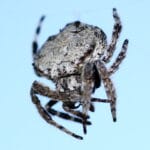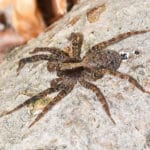Many people imagine intricate, wheel-shaped webs when they think of spiders. But when it comes to tarantulas, these often-feared creatures don’t quite fit the mold. While they may not be the master weavers of the spider world, tarantulas utilize their silk in fascinating and unexpected ways.
Why Does My Tarantula Web?
Tarantulas, like all spiders, produce silk, but they don’t use it to spin the classic webs we typically associate with spiders. Instead, they’ve evolved to use their silk for a variety of purposes, from creating cozy homes to detecting prey. Let’s delve into the intriguing reasons behind their silken creations.
A Silky Sanctuary
Think of a tarantula’s burrow as its own private apartment, and like any homeowner, they like to spruce up their space. Tarantulas use their silk to line their burrows, creating a more stable and comfortable living environment. This silk lining helps to:
- Reinforce burrow walls: This prevents collapse and provides a more secure dwelling.
- Regulate humidity: Silk helps maintain optimal moisture levels within the burrow.
Dinner Bell…Eventually
While they don’t build webs to snare their meals, tarantulas are far from passive hunters. They strategically place incredibly fine silk threads around the entrance of their burrows, acting as a sensitive alert system. These “tripwires” serve a crucial role in their hunting strategies by:
- Detecting vibrations: When an unsuspecting insect or even a potential predator brushes against these threads, it creates tiny vibrations.
- Alerting the tarantula: The tarantula, highly sensitive to these vibrations, is immediately alerted to the presence of a potential meal – or threat – nearby.
Scaling New Heights
Don’t let their size fool you; many tarantulas are surprisingly adept climbers. Their secret weapon? You guessed it—silk! They use it as an anchoring system, allowing them to:
- Explore vertical surfaces: This ability expands their hunting grounds and allows them to navigate a wider range of environments.
- Stay safe while climbing: The silk acts as a safety line, preventing potentially fatal falls from branches or other high places.
Love is in the Air (and Silk)
Reproduction is a serious matter in the tarantula world, and silk plays a vital role in ensuring the survival of the next generation.
- Protective nurseries: Female tarantulas meticulously create intricate silk mats upon which they deposit their eggs. This silken cocoon provides a safe haven, protecting the developing spiderlings from predators and the elements.
- Sperm storage: Male tarantulas spin what is known as a “sperm web.” This specialized web serves as a safe place to deposit their sperm, which is later collected by the female for fertilization.
No Web? No Worries (Maybe)
If you’re a tarantula owner and notice a lack of webbing, don’t panic just yet. There are a few reasons why your eight-legged friend might not be spinning much silk:
- Captive comfort: Tarantulas in captivity are provided with a consistent food source and a controlled environment, reducing their need to build elaborate webs for hunting or shelter.
- Low stress levels: A lack of webbing can actually be a good sign, indicating that your tarantula is happy and content with its environment.
However, if your tarantula suddenly stops webbing or exhibits other changes in behavior, it’s essential to consult with a veterinarian specializing in exotic animals. Like any other pet, tarantulas can experience stress or illness, and changes in their webbing habits can be an early indicator that something is amiss.
Can a Tarantula Bite You?
While their large size and formidable fangs might seem intimidating, tarantulas are generally not aggressive creatures. Biting is often a last resort for these arachnids.
Defense Mechanisms:
Tarantulas have a few tricks up their (eight) sleeves when it comes to defending themselves. Biting is usually a last resort, employed when they feel threatened and have no other options:
-
Urticating Hairs: Many tarantula species possess urticating hairs on their abdomens. These barbed hairs are a primary defense mechanism. When threatened, a tarantula will flick these hairs towards the perceived danger. While not dangerous, contact with urticating hairs can cause irritation and discomfort.
-
Threat Posture: When they feel threatened, tarantulas will often adopt a defensive posture to ward off potential attackers. This may involve:
- Rearing up: Raising their front legs and displaying their fangs.
- Hissing: Some species are capable of producing a hissing sound as a warning.
Bite Severity:
-
Toxicity: For the majority of tarantulas, their venom is relatively mild to humans. A bite may result in localized pain, swelling, and redness, similar to a bee sting. However, it’s important to note that individual reactions can vary, and some people may experience more severe allergic reactions.
-
Seeking Medical Attention: If you are bitten by a tarantula, it is always best to err on the side of caution and seek medical attention, especially if you have any known allergies or experience unusual symptoms.
Avoiding Bites:
The best way to avoid getting bitten by a tarantula is to treat it with respect and avoid provoking it.
- Observation over Handling: Observe these fascinating creatures in their natural habitat or in responsible captive environments, but avoid unnecessary handling.
- Respect their space: Never attempt to corner or trap a tarantula.
Do Tarantulas Produce Silk From Their Feet?
The notion of tarantulas shooting silk from their feet, Spiderman-style, is a captivating one that has sparked much debate among scientists and arachnid enthusiasts alike.
The Evidence:
The “foot silk” theory gained traction in 2006 when a research study observed tarantulas seemingly leaving behind trails of silk as they climbed vertical surfaces. This observation led to speculation that tarantulas might possess silk-producing structures in their feet, allowing them to:
- Enhance their grip: The silk could provide extra traction, almost like built-in climbing shoes, enabling them to scale smooth and challenging surfaces.
The Counterarguments:
The scientific community remains divided on the validity of “foot silk” in tarantulas.
-
Spinneret Origin: Critics of the foot silk theory argue that the silk threads observed in the 2006 study could have originated from the tarantula’s abdomen and were simply picked up by their feet as they moved.
-
Microscopic Structures: Others propose that while tarantulas may not intentionally spin silk from their feet, microscopic structures called “spigots” on their feet might play a role in silk production.
Alternative Explanations for Climbing Prowess:
Tarantulas are remarkably adept climbers, even without confirmed “foot silk.” Their anatomy holds the key to understanding their grip:
-
Setae: Thousands of microscopic hairs, known as setae, cover their feet. These hairs create molecular forces, allowing them to adhere to various surfaces, including those that appear smooth to the human eye.
-
Claws: In addition to setae, tarantulas possess small claws on their feet, which provide extra grip, particularly on rough surfaces.
The Verdict:
The question of whether or not tarantulas can genuinely spin silk from their feet remains a subject of ongoing scientific inquiry. More research is needed to unravel the mysteries of tarantula silk and definitively confirm or refute the existence of “foot silk.”
Looking Ahead:
As scientists continue to explore the intricacies of the tarantula world, we are likely to gain a deeper appreciation for the complex and often surprising ways these creatures interact with their environment. The ongoing debate surrounding “foot silk” highlights how much more there is to learn about these fascinating arachnids.
Internal Links:
Curious about the unique defense mechanism of locusts? Discover the fascinating truth behind do locusts bite in this comprehensive article.
Delve into the remarkable journey of the dung beetle ark, revealing the extraordinary adaptability and resilience of these tiny creatures.
- Unraveling Einstein’s Legacy: Who Inherited His Genius? - July 14, 2025
- Unlock Einstein’s Family Tree: Bernhard Caesar & Untold Stories - July 14, 2025
- Unveiling Bernhard Caesar Einstein: His Life & Albert Einstein’s Legacy - July 14, 2025

















2 thoughts on “Do Tarantulas REALLY Spin Webs? Unraveling the Silken Mysteries”
Comments are closed.